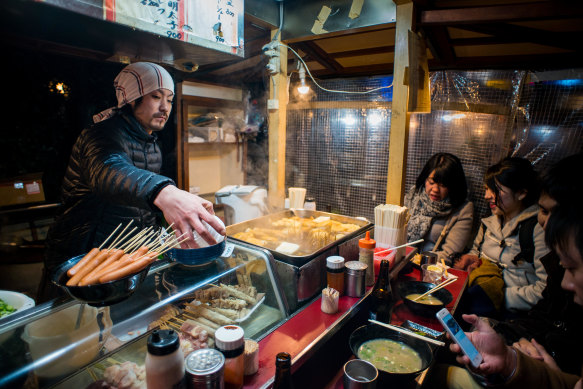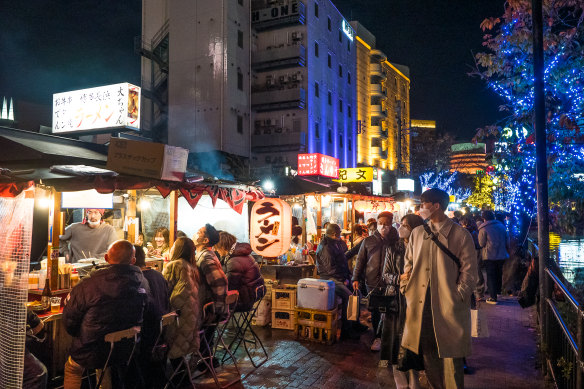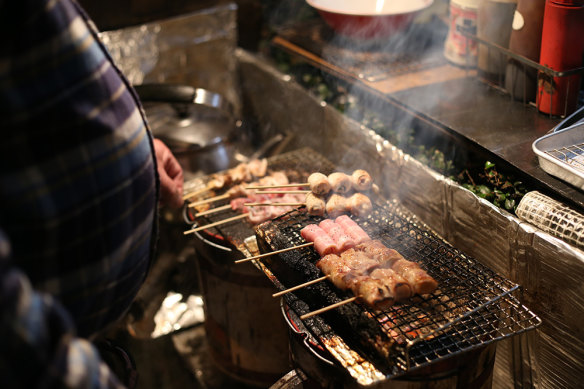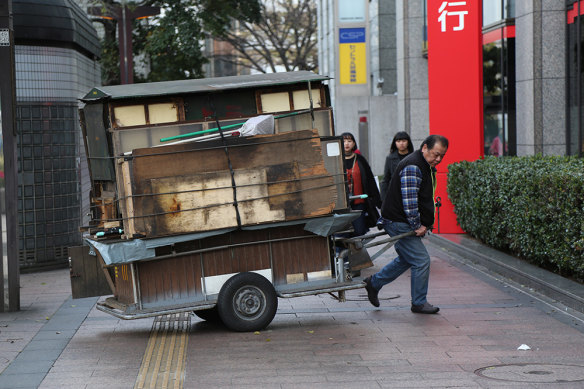This was published 1 year ago
Japan’s answer to hawker stalls is a deliciously unique experience
By Emily McAuliffe
I don’t know where the food is coming from. I don’t know where the frying pans are coming from. Where on Earth is the flavour coming from? Though I have a front-row view of the compact kitchen – if you can call it that – I’m struggling to keep up with the portly man in a tea-towel bandana who is swiftly pulling out and putting away pots, pans, oils and spices from some kind of Mary Poppins cupboard.
He silently snatches at notes passed to him by his colleague, scans the scribbled order, then sets to work at his small cooktop, preparing oden (a simple hot pot), yakitori and some of the best dumplings I’ve ever had.

Yatai dining in Fukuoka is Japan’s answer to Singapore’s hawker centres.Credit: Alamy
My partner and I sit tightly wedged between Fukuoka locals along an angular U-shaped bar – two people on our left, eight on our right. It’s a full house. We’ve been shuffled into the tent-like structure by a man whose sole job is shepherding the crowd that is quickly multiplying on the footpath outside, and a third man has slapped a paper menu scrawled with Japanese characters in front of us. None of the men are rude, just efficient.
This is the nightly dance of Fukuoka’s yatai – temporary food stalls that pop up every evening from about 6pm until beyond midnight. Think Singapore’s hawker stalls, but with a Cinderella-esque directive to vanish before daybreak to avoid turning into a dumpling (or breaching city regulations, rather).
Yatai were once found all over Japan, with soba vendors thought to have kicked off the trend during the Edo period (1603–1868). These days, however, yatai are synonymous with Fukuoka, which hosts about 100 stalls across the city every night.

Yatai is thriving in Fukuoka, which hosts about 100 stalls across the city every night.Credit: Emily McAuliffe
The triumph of yatai culture in Fukuoka amid its demise in other Japanese cities is curious, so, between slurps of rich tonkotsu ramen (a Fukuoka specialty), I ask a local what she believes to be the reason. “Mmm, I think we are more resilient … or, resistant, maybe,” she says slowly, searching for the right word. Then, covering her mouth to stifle a shy giggle, she adds, “Oh, and we really like to eat.”
On face value – with their eight to 15 stools, hack kitchen and awnings that pop out like Buzz Lightyear wings before service – yatai look like a casual affair, but the tightly regulated establishments have long been embroiled in politics.
Rewinding to the 1960s, Fukuoka’s yatai scene flourished in a pendulum swing away from the ban imposed on food stalls during World War II. At its peak, more than 400 stalls operated across the city, but hygiene concerns, unpaid rent and neighbourly tiffs marred the industry and the number fell to about 220 in the mid-90s.
The government viewed yatai as blemishes on a country trying to exude a dapper first-world image and, short of shutting them down completely, in 1995 mandated that yatai must be run by a single generation, and must be handed down to a direct family descendent. Kids not interested? Then pack your saucepans. Consequently, the number of yatai operating in the city dwindled further, and by 2010, only 150 remained.

Yatai stalls could previously only be handed down to family members, a rule that was scrapped in 2013.
Close to midnight and in search of a snack, we stroll along Nakasu Island’s riverfront, browsing the bumper-to-bumper food stalls, many of which can only be judged by hazy outlines of people behind thick plastic curtains and rows of shoes sticking out beneath them. We see a couple push through the curtain to leave a yatai up ahead, so poke our heads in. We’re invited to take the vacated seats and perch next to an animated group of Japanese uni students, seemingly fuelled by Fukuoka’s popular highball mixed drinks.
After placing an order with the quartet of young men bantering behind the counter, I wonder what the relationship is. “Are you all friends?” I ask. The most exuberant of the group, wearing a black shirt adorned with sequins, replies, pointing to the others one by one: “Friend. Friend. Slave.” The chap washing up in a small sink looks over his shoulder and shakes his head with a wry smile, while the others howl with laughter.
The sequin-topped 24-year-old, who introduces himself as Takada Yoshimasa, represents a new wave of yatai owners benefiting from a regulation amendment passed in 2013, which removed the requirement for yatai to be passed down through families. In a turning of the tide, the government started to recognise the tourist-luring potential of yatai and introduced an open recruitment process to boost stall numbers.

Stalls must be packed up and removed at the end of every night’s business.
At just 20, Takada – who went on to become the city’s youngest yatai owner – was able to make an application then sit a test and an interview to be considered for a sought-after position on the pavement, which, with the right balance of hospitality and customer rotation, can be lucrative. For some proprietors, a street stand is a launchpad to a restaurant, but for others, yatai is life. And so long as peckish diners are drawn to the glow of their tiny kitchens, they will keep belting out pots, pans and flavour, and the nightly magic will continue.
THE DETAILS
FLY
Qantas and Jetstar fly into Tokyo’s Narita Airport, and Jetstar Japan connects to Fukuoka. You can also reach Fukuoka (Hakata station) from Tokyo via shinkansen (bullet train).
STAY
The Blossom Hakata Premier is an easy walk from the yatai action around Nakasu Island and Tenjin. See jrk-hotels.co.jp/Hakata_premier/en
MORE
Emily McAuliffe travelled as a guest of Fukuoka Prefecture Tourism Association and Visit Kyushu.
Sign up for the Traveller Deals newsletter
Get exclusive travel deals delivered straight to your inbox. Sign up now.